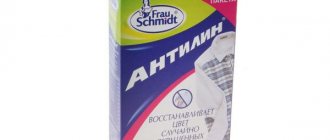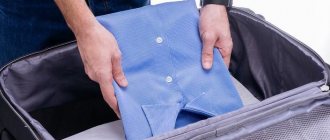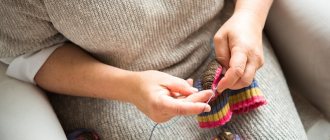Everyone has encountered a problem when things made of synthetics, wool or natural silk lose their shape, do not flow, but stick to the body and even sparkle. Electrification of fabrics spoils the appearance of the outfit and causes discomfort.
This process is associated with dryness, and you can easily get rid of it or prevent electrification even before putting on the outfit. Let's figure out what to do to prevent clothes from becoming electrified.
Heavy artillery
If there is very little time to get rid of static from clothes, then the best way to remove static is with varnish or a special antistatic agent. As for the first, regular hairspray can be sprayed onto the inside of the clothing. This method is quick and effective, the main thing is to wait for the clothes to dry.
If the problem with electrification of things and hair is permanent, it is better to purchase a special antistatic agent, which is sold in the household chemicals department of any store. There are a lot of brands - almost every manufacturer produces two types of antistatic spray: water-based and alcohol-based.
It is better to use alcohol antistatic in a well-ventilated area, as it has a rather pungent odor that takes a long time to dissipate. A water-based antistatic agent for textiles is much more convenient, as it does not retain the smell of alcohol on clothing and is completely safe for health. The price of both products is quite affordable, and the bottle is quite large and will last for a long time.
Using an antistatic agent is the most convenient way to combat static electricity, but it is worth trying others that are no less simple and comfortable. And following simple rules in choosing and caring for wardrobe items will help you forget about electrifying clothes for a long time.
Why is it necessary to have an antistatic agent?
An antistatic agent is a liquid under pressure in an aerosol can. It prevents electrification of the fabric and thus fights sticking. Most antistatic agents contain ethanol, glycerin, propane, butane and fragrances. All products of this type are divided into 2 large groups: alcohol and water. Alcohol-based antistatic agents usually last longer but are more likely to cause respiratory irritation. Water-based products are safer for health, but sometimes you have to treat clothes with them even several times a day.
It is enough to spray an antistatic aerosol on the desired area, and the clothes will take on a normal appearance and will flow freely in waves. It all sounds very simple, but there are a few nuances to consider:
- Shake the can thoroughly before use to mix the liquid.
- You need to keep the cylinder no closer than 20 cm from your clothes, strictly vertically.
- Do not spray the product too liberally - this will cause unsightly white spots to form on the fabric after it dries.
- Spray the liquid only on the hem itself, and not on the tights, otherwise they will still stick.
- Use the aerosol only in a room that can be ventilated. Antistatic particles strongly irritate the bronchi and often provoke an allergic reaction.
This tool is convenient to use. If necessary, a small cylinder can be placed in your purse and used on the spot.
Sneakers
Shoes for every day should be of high quality, so you shouldn’t look for sneakers that cost just a penny. In the mass market (Mango, Asos, River Island) you can find budget basic models that will not harm your feet and will not make your legs float. They are in all collections and are worn almost all year round. The most you can spend on is original sneakers for going out, if your lifestyle requires it.
How to wash faded clothes
Don't wonder how to wash your clothes without fading. To do this, follow some recommendations.
- Be sure to wash in cool water. On the washing machine display, select a temperature setting of no more than 40 degrees. Good powders do a great job of removing stains and don’t require high heat. The exception is washing light-colored cotton or linen bed linen and towels.
- If you suspect that the material will stain the water, a reliable way to wash clothes without fading is to use special napkins to catch the dye. They are produced by Dr. Beckmann. For colored material that is prone to shedding, you need to put 3 napkins in the drum along with the clothes and start the delicate mode. The napkins will absorb the dye, and things will become clean and bright.
To prevent laundry from fading, you need to wash it, twisting it at low speed. For delicate items, it is advisable to use a laundry bag. In it, the fabric is less deformed and curled.
The dress sticks to the tights. What to do?
Tights or stockings paired with a dress often stick to each other. As a result of this process, the dress can rise much higher than the required length when walking. But don’t forget that long dresses add femininity and elegance, help hide figure flaws and highlight its advantages. Follow the link to figure out what they can be and how to choose them correctly.
What can I do to prevent my skirt from sticking to my tights and from lifting up if there is no antistatic agent? You can try one of the following methods:
- Apply a thin layer of hand cream to your feet. The appearance of moisture significantly reduces friction.
- Apply a small amount of baby powder to areas of skin that are exposed to static electricity in clothing.
- Run a bar of soap over your tights or the inside of your dress.
- To urgently solve the problem of electrification of clothes, you can apply a little fabric softener to your hands and run them over your tights.
- Wet your hands in a solution of 1 teaspoon salt and a glass of water. Run your hands over the clothing several times.
- When rinsing synthetic clothing, use a special fabric conditioner with an antistatic effect.
Important! Before using such conditioners, read the instructions. It may not be suitable for all types of fabric.
- Clear water can also help remove static electricity. To do this, run wet hands over the clothing. The only significant drawback of this method is the short duration of the result.
- The right shoes can solve this problem. Shoes must be leather or have rubber soles. Insoles or strips with an antistatic effect are also quite effective.
- Antistatic wipes do a great job of solving the problem. Lift the skirt and rub it with a napkin from the wrong side. This way the static will instantly transfer to the napkin.
- Most often, static electricity occurs in winter, when indoor air is dry. Air humidifiers cope well with the problem: the electrification of the air will disappear some time after the humidifier starts operating.
- To remove static electricity from a dress, hang it in the bathroom for a few minutes immediately after showering. Increased humidity neutralizes static electricity.
- Hard water is one of the causes of electrification of tissues. Using conditioners to soften the water when washing, you will prevent the accumulation of static charges on fabrics.
Powder selection
To wash colored items, purchase the necessary powder so that they do not fade. You can use a universal product to preserve the brightness of the fabric. Such powders are usually marked color.
There will be no questions about how to wash so that nothing fades if you use liquid gels. Their structure helps strengthen color and maintain brightness. For black and colored products, remember to purchase separate powders designed for those colors.
Most importantly, do not soak faded clothes in bleach, and avoid stain removers. Poorly dyed fabric will not withstand such exposure and will lose color.
#4 A little extra
If you like to dress up, then the style of Indian women will definitely suit your taste. This is a special kind of art. So French women, for example, will most likely wear a slip dress to a celebration, while American women will prefer mini or tight silhouettes. Indian women will attract attention with a riot of colors, rhinestones and unusual styles. Juhi will definitely advise you to pay attention to theatrical blouses, and Santoshi - to sequins and multi-colored stones.
@juhigodambe
@santoshishetty
How to buy something that doesn't fade
To do this, you need to be careful and choose the right item when purchasing. What fabric does not fade when washed? Resistant to color loss:
- polyester;
- Jersey;
- smooth knitwear.
High-quality cotton and other dense materials also shed less.
Sometimes you can tell if a fabric is fading by touching it. Crumple it in your hand. If it “crunches” a little, this indicates that excess paint was used to paint it. This means that when washing there is a high chance that the clothes will fade.
A label can say a lot. When it warns you to turn the item inside out when washing or wash it in cold water, the fabric is most likely poorly dyed.
How to wash cotton so it shrinks
In most cases, cotton products stretch due to washing at the wrong temperature, spin conditions or during prolonged wear. It is worth knowing that high-quality cotton does not shrink or stretch in 95% of cases.
- Before processing, examine the tag on the back of the product. The manufacturer indicates the recommended washing temperature at which the product will not fade or shrink. You need to do exactly the opposite. For example, if the label says “wash at 30-40 degrees,” place the clothes in the machine and set the mode to 60 degrees, no more. It is important to know that only light and dark things can be processed in this way; colored clothes will fade and become dull. At the same time, also pay attention to the degree of spin, add another 150-200 revolutions to the indicator indicated on the label.
- At this stage, you need to remove the item from the machine and dip it into the prepared solution. Pour 5-7 liters of boiling water into a basin, add 1 cap of fabric softener. Place the product in the container, place polyethylene on top, wait about 7 minutes. During this time, the item will become smaller by about 1 size. If you need to achieve more effective results, leave the clothes to soak for a quarter of an hour.
- At the end of the manipulations, you need to take out the cotton product and place it in the dryer, so it will shrink another half size. If this is not possible, place the clothes on a flat wooden surface, pat dry with a cotton towel and hang in the sun to dry.
How to wash jeans to make them shrink
All jeans have an unpleasant stretching property. As a rule, trousers become larger after 5-6 wears, and they begin to slide off the hips and gather in folds.
- Please note that stretch jeans are very difficult to tighten, since the fabric contains a large amount of synthetic fibers. It is easier to tighten natural jeans; they lend themselves well to heat treatment.
- It is worth understanding that when washed at high temperatures, jeans may change shade. As a rule, trousers become an order of magnitude dull. Another important feature is the fact that after “cooking” the trousers, not only the size of the product will change, but also the length.
- To achieve the desired result, it is enough to wash the jeans in a machine at a temperature of 60-70 degrees, with a prerequisite for a spin cycle of 600-900 rpm.
- After washing, you need to put the trousers in the machine to dry or use clotheslines, placing the clothes in direct sunlight.
It is not difficult to “fit” clothes if you have sufficient knowledge. In the case of synthetics, you will have to try, but with cotton, wool, and denim there should be no problems. The main thing is not to twist the product too much, dry the clothes under direct ultraviolet light. Follow the practical recommendations, everything will definitely work out.
How to wash synthetics so that they shrink
By and large, synthetic products do not shrink. This is especially true for fabrics such as nylon, polyester, and acrylic. Usually clothes are sent to dry cleaners, where professionals do everything themselves. If this option is not available, use practical recommendations.
- To shrink a synthetic product, it is enough to add 10 degrees to the temperature indicated on the label. However, you should not add conditioner; it prevents nylon and polyester from shrinking. Set the spin speed to maximum (800-1000).
- Ice water will help make your favorite item 1-1.5 sizes smaller. The holding time in this case is about 3-5 hours. At the end of the manipulations, you need to collect the water with blotting movements using a towel.
- In cases where it is necessary to tighten a product made of spandex and lycra, none of the home methods will be effective. To solve problems, contact the studio.
- In the summer, dry clothes made from synthetic fabrics under direct ultraviolet light. In winter, give preference to heating radiators.
- Some housewives use the “cotton” mode when washing synthetics. It all depends on the constituent materials of the fabric; you can take risks if you wish. In this case, the washing temperature will be 60 degrees.
Woolen products are most susceptible to stretching, especially around the shoulders and waist. Before starting the procedure, read the manufacturer's information on the label.
- The difference between the recommended and actually set temperature should not exceed 20 degrees. As a rule, sweaters are washed at 30-40 degrees, so it turns out that you need to process clothes at 50-60 degrees.
- Place the item in the machine, add baby laundry detergent. Turn on the desired temperature and spin no more than 500 rpm. Wait until the procedure is completed. Important! If you wash woolen items in a machine, give preference to the “wool” and “hand wash” modes; do not use a spin cycle of more than 600 rpm.
- Prepare a solution of 5 liters of water (temperature 40 degrees), add 1 cap of fabric softener, and dip the item in the liquid. Rinse for 5 minutes.
- Now fill a basin with 5 liters of water (temperature 50 degrees), do not add rinse aid, repeat the previous manipulations. An important feature of wool processing is considered to be that clothes shrink due to sudden temperature changes.
- You can do something drastic: after washing the item in the machine, take it out and put it in a basin of ice water (add ice cubes first). Then wait about 10 minutes, rinse the clothes at 40 degrees. Repeat steps 4-5 times.
- After washing woolen clothes, you need to move on to direct drying. Do not twist the product, gently squeeze it into a fist, squeezing out excess moisture. Now lay a thick terry towel on a flat surface, lay out the sweater and wrap it around it. Apply a little pressure until the water comes out.
- You cannot hang a woolen item on hangers, otherwise the item will stretch out and all efforts will be in vain. Final drying is carried out on a horizontal surface, heating radiators or other devices that require heat treatment. For example, wrap a sheet around the radiator, carefully lay out the sweater and straighten it out.











